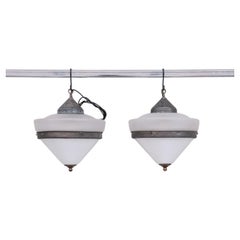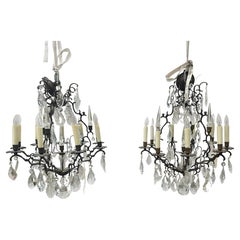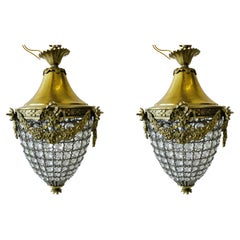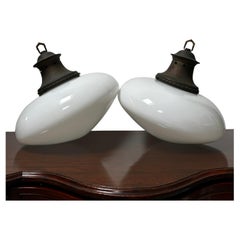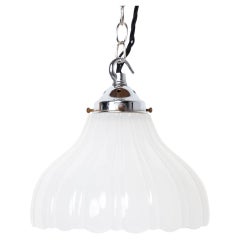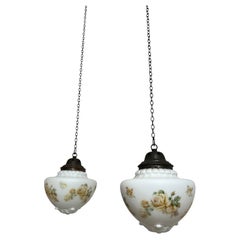Antique Pair Pendants
to
18
226
165
256
159
115
60
52
26
16
13
13
12
11
10
10
8
8
6
5
5
5
4
4
4
4
4
3
3
2
2
2
2
2
1
1
1
1
1
14
2
2
2
2
Sort By
Pair of Two Tone Antique French Pendant Lights
Located in London, GB
A pair of antique pendant lights of remarkable quality.
France, circa 1920s.
Unique swirly
Category
Vintage 1920s French Chandeliers and Pendants
Materials
Metal
Pair Of Antique Etched Frosted Glass Teardrop Pendant Lights
Located in Brooklyn, NY
Pair of antique, late 19th century, pendant lights featuring outstanding, 8 inch teardrop shaped
Category
Antique Late 19th Century American Industrial Chandeliers and Pendants
Materials
Brass
Antique Platinum, Edwardian Aquamarine & Diamond Lavalier Pendant Necklace
Located in Brighton, GB
Antique Aquamarine Necklace
Platinum
Circa 1900
Stunning, antique lavalier pendant necklace
Category
Early 20th Century European Edwardian Pendant Necklaces
Materials
Aquamarine, Diamond, Platinum
Pair of Antique Neoclassical Versailles Bronze and Crystal Pendant Chandeliers
Located in Dallas, TX
A charming pair of antique neoclassical Versailles painted bronze and Swarovski Strass crystal
Category
Vintage 1940s French Neoclassical Chandeliers and Pendants
Materials
Crystal, Bronze
$8,800
H 31 in Dm 43 in
Pair of Antique style Pendant Lights in Solid Brass & Cut Glass
Located in Los Angeles, CA
Introducing our exquisite Pair of Antique Style Pendant Lights, crafted with utmost precision in
Category
Vintage 1980s Spanish Moorish Chandeliers and Pendants
Materials
Brass
Pair Set Antique Vintage Ovaloid Church Opaline Ceiling Pendants Light Lamp
Located in Sale, GB
- A matching pair of extra large oval lid opaline glass ceiling pendants with heavily patinated
Category
Early 20th Century British Chandeliers and Pendants
Materials
Opaline Glass
$3,638 / set
H 15.75 in W 15.75 in D 15.75 in
Pair of Antique Moonstone Glass Pendant Lights with Chrome Fittings
By Jefferson Electric Co.
Located in Nottingham, GB
Medium Moonstone Glass Pendant Lights with Chrome fittings
SOLD AS A PAIR
Elegant fluted design
Category
Vintage 1930s British Art Deco Chandeliers and Pendants
Materials
Brass
Pair Antique Art Deco French Pendant Baccarat Style Crystal Basket Chandeliers
By Baccarat
Located in Coimbra, PT
Pair of Antique French Pendant Baccarat Style Crystal Basket Chandelier
Dimensions:
Diameter 11.03
Category
Early 20th Century French Hollywood Regency Chandeliers and Pendants
Materials
Crystal, Brass
$6,981
H 31.5 in Dm 11.03 in
Pair Antique Vintage Edwardian Satin Opaline Milk Glass Ceiling Pendants Light
Located in Sale, GB
- A beautiful pair of Edwardian satin opaline ceiling pendants with floral decoration, England
Category
Early 20th Century British Chandeliers and Pendants
Materials
Copper
$2,236 / set
H 11.03 in W 10.24 in D 10.24 in
Contemporary Pair of Italian Pink Gold Murano Glass Brass Flower Chandeliers
By Cosulich Interiors & Antiques
Located in New York, NY
Put Blossoms and flowers in your home! This is an exclusive organic design, entirely handcrafted in Murano - Italy, in the shape of a lotus flower with textured pink frosted reeded M...
Category
2010s Italian Organic Modern Chandeliers and Pendants
Materials
Brass, Gold Leaf
$17,550 / set
H 42 in Dm 27.5 in
Pair Antique Art Deco Duplexalite Opaline Glass Ceiling Pendant Light Chandelier
Located in Sale, GB
- An incredibly rare pair of Duplexalite ceiling pendants, American circa 1920.
- These look to be
Category
Early 20th Century American Chandeliers and Pendants
Materials
Porcelain, Opaline Glass
$4,199 / set
H 23.63 in W 16.15 in D 16.15 in
Pair of Antique 12" Milk Glass Hanging Disc Pendants , c. 1914
Located in Pasadena, CA
Illuminate your room with this pair of charming antique milk glass hanging disc pendants. They have
Category
Early 20th Century Chandeliers and Pendants
Materials
Brass
Pair Vintage Antique Two Part Copper Holophane Glass Ceiling Pendants Light Lamp
By Holophane
Located in Sale, GB
- A wonderful pair of two part copper Holophane ceiling pendants, England circa 1920.
- Prismatic
Category
Early 20th Century British Chandeliers and Pendants
Materials
Copper
$3,357 / set
H 10.24 in W 10.24 in D 10.24 in
Two Antique English Pendant Lights
By Faraday & Son
Located in Wormelow, Herefordshire
A pair of antique English pendant lights by Faraday & Son of London. These beautiful nickel plated
Category
Early 20th Century English Edwardian Chandeliers and Pendants
Materials
Brass, Nickel, Metal
Pair Set Antique Vintage French Frosted Glass Floral Ceiling Pendants Light Lamp
Located in Sale, GB
- A fabulous pair of frilly pendant light shades, French circa 1930.
- Frosted glass 'tulipe
Category
Early 20th Century French Chandeliers and Pendants
Materials
Glass
$694
H 6.3 in W 5.91 in D 5.91 in
Great Pair / Set of Good Size Antique White Alabaster Pendant Lights / Fixtures
Located in Lisse, NL
Truly timeless design and beautifully polished condition, rare set alabaster pendant lights.
If
Category
Early 20th Century French Art Deco Chandeliers and Pendants
Materials
Alabaster, Brass
$9,027 / set
H 38 in Dm 15.7 in
Pair Set XL Antique Bauhaus Opaline Milk Glass Ceiling Pendant Light By Siemens
By Siemens
Located in Sale, GB
- An original and extremely rare pair of large opaline Bauhaus ceiling pendants by Siemens, Germany
Category
Early 20th Century German Chandeliers and Pendants
Materials
Opaline Glass
$3,357 / set
H 17.72 in W 14.97 in D 14.97 in
Pair of Antique Art Deco Sunco Two-Part Opaline Glass Pendant Light, C.1930
Located in London, GB
An incredible pair of Art Deco pendant lights made in England by Sunco. c.1930
Moulded crisp
Category
Early 20th Century Dutch Art Deco Chandeliers and Pendants
Materials
Glass
$1,794 / set
H 15.75 in Dm 11.82 in
Stilnovo 1958 Italian Black White Glass Pair of 6-Light Teak Brass Chandeliers
By Stilnovo, Cosulich Interiors & Antiques
Located in New York, NY
-century modern organic and airy structure supporting 6 cylindrical vase-shaped pendants in a frosted white
Category
Vintage 1950s Italian Mid-Century Modern Chandeliers and Pendants
Materials
Metal, Brass
$9,000 / set
H 41 in Dm 27 in
Antique Pair of Italian Chandeliers
Located in Schellebelle, BE
An exceptional pair of Antique Italian Chandeliers made out of Gilded Patinated Wood, probably from
Category
Antique Late 17th Century Italian Chandeliers and Pendants
Materials
Fruitwood
Pair of Crystal Antique Chandeliers
Located in Austin, TX
Pair of chandeliers from France. This rare pair of fixtures feature multiple cut crystal strands
Category
Antique 1890s French Chandeliers and Pendants
Materials
Crystal, Brass
Pair of Antique Neoclassical Style Chandeliers
Located in London, GB
A beautiful pair of antique Neoclassical style chandeliers, made in England and dating from around
Category
Vintage 1950s French Neoclassical Chandeliers and Pendants
Materials
Brass
Antique Pair of Gilt-bronze Chandeliers
Located in London, GB
A pair of Art-deco style gilt-bronze and frosted glass chandeliers, early 20th Century.
Category
Early 20th Century Art Deco Chandeliers and Pendants
Materials
Bronze
Pair of Paavo Tynell Style Brass Pendants
By Paavo Tynell
Located in Tarrytown, NY
brass, satin brass, antique brass, polished nickel and satin nickel.
Made to order.
Category
2010s American Mid-Century Modern Chandeliers and Pendants
Materials
Brass
Pair of Opaque Glass and Brass French Opaline Pendants
Located in London, GB
A pair of antique small pendants.
France, c1920s.
Opaque/etched glass pendant with brass gallery
Category
Early 20th Century French Chandeliers and Pendants
Materials
Brass
Antique Pair of English Silver Plated Chandeliers 20th Century
Located in London, GB
This is a beautiful pair of antique English silver plated eight light chandeliers, circa 1920 in
Category
Early 20th Century English Rococo Chandeliers and Pendants
Materials
Silver Plate
$3,294 / set
H 22.45 in W 30.71 in D 30.71 in
Antique Pair Hand Blown Glass Four Tier Chandeliers
Located in Toledo, OH
Pair antique four tier crystal, blown glass and brass chandeliers. Crystal draped beads with cut
Category
20th Century Chandeliers and Pendants
Materials
Glass
Pair of Antique Swedish Crystal Chandeliers, Sold Individually
Located in New York, NY
A pair of circa 1900s Scandinavian chandeliers with 12 lights. Sold individually.
Measurements
Category
Antique Early 1900s Swedish Chandeliers and Pendants
Materials
Crystal, Metal
Antique Pair English 41 light Ballroom Crystal Chandeliers 1920s
Located in London, GB
This is a beautiful pair of English Ballroom crystal chandeliers each with forty-one lights
Category
Vintage 1920s English Chandeliers and Pendants
Materials
Crystal
$19,629 / set
H 43.31 in W 41.34 in D 41.34 in
Pair of Large French Antique Overlay Glass Chandeliers by Baccarat
By Baccarat
Located in London, GB
Pair of large French antique overlay glass chandeliers by Baccarat
French, Late 19th Century
Height
Category
Antique Late 19th Century French Belle Époque Chandeliers and Pendants
Materials
Glass
$392,583 / set
H 59.06 in Dm 39.38 in
Antique Pair of English Giltwood Six Branch Chandeliers 20th Century
Located in London, GB
This is a beautiful pair of antique English hand carved giltwood six light chandeliers, circa 1920
Category
Early 20th Century English Regency Chandeliers and Pendants
Materials
Giltwood
$2,628
H 27.96 in W 27.17 in D 27.17 in
Pair of Cast Bronze Antique Chandeliers. Sold individually.
Located in New York, NY
Pair of circa 1900 English ten-light bronze chandeliers with thistle & foliage motif on body and
Category
Antique Early 1900s English Chandeliers and Pendants
Materials
Bronze
Pair Antique French Crystal and Gold Bronze Chandeliers, Circa 1890.
Located in New Orleans, LA
Pair Antique French Crystal and Gold Bronze Chandeliers, Circa 1890.
Category
Antique Late 19th Century French Chandeliers and Pendants
Materials
Crystal, Bronze
Antique Pair Silver Plated Jasperware two branch wall lights sconces
Located in London, GB
This is a stunning Antique pair of ormolu and porcelain twin branch wall lights, Circa 1900 in date
Category
Antique Early 1900s Chandeliers and Pendants
Materials
Silver, Ormolu
$1,612
H 18.12 in W 11.82 in D 5.52 in
Pair of Antique Italian Crystal and Amethyst 14 Light Chandeliers
Located in Dallas, TX
Wonderful pair of antique Italian crystal and amethyst chandeliers with 14 lights. Covered in
Category
Early 20th Century Italian Chandeliers and Pendants
Materials
Amethyst, Crystal, Metal
$14,240 Sale Price / set
20% Off
H 36 in Dm 30 in
A pair of antique French silvered bronze and crystal chandeliers
Located in SON EN BREUGEL, NL
A beautiful pair of French crystal chandeliers.
Each with 8 lights.
The chandeliers are richly
Category
Early 20th Century French Louis XV Chandeliers and Pendants
Materials
Crystal, Bronze
Pair of Large and Important Antique French Empire Gilt Bronze Chandeliers
Located in New York, NY
Pair of large and spectacular important antique French Empire neoclassical gilt bronze and white
Category
Early 20th Century French Empire Chandeliers and Pendants
Materials
Bronze
$35,000 / item
H 38 in Dm 40 in
Pair of Antique French Empire Style Figural Gilt & Patina Bronze Chandeliers
Located in New York, NY
A Pair of unusual Antique French Empire style gilt bronze and patinated bronze multi light figural
Category
20th Century French Empire Chandeliers and Pendants
Materials
Bronze
$29,500 / set
H 30 in Dm 26 in
18th Century Italian Pair of Large Lustres Piemontese - Antique Wood Chandeliers
Located in West Palm Beach, FL
An antique pair of late 18th century wooden carved chandeliers composed of six arms leaf decorated
Category
Antique Late 18th Century Italian Baroque Chandeliers and Pendants
Materials
Wood
$38,000 / set
H 60 in Dm 54 in
A pair of gilt brass and crystal Gustavian style antique chandeliers
Located in SON EN BREUGEL, NL
An elegant pair Gustavian style chandeliers.
Each with 7 lights: 5 lights around the chandelier and
Category
Early 20th Century Swedish Gustavian Chandeliers and Pendants
Materials
Crystal, Brass
$8,726 / set
H 27.56 in Dm 21.26 in
Antique Pair Louis Revival Ballroom Cut Crystal Tent Chandeliers 20th Century
Located in London, GB
This is a beautiful pair of Louis Revival 20 Light Ballroom Cut Crystal and Bronze Tent
Category
Vintage 1920s English Revival Chandeliers and Pendants
Materials
Crystal, Bronze
$12,899 / set
H 49.22 in W 47.25 in D 47.25 in
Pair Fine Brass Empire Sac a Pearl Chandelier Crystal Lustre Lamp Antique
Located in Berlin, DE
Pair of Antique Empire Sac-à-Perle Chandeliers – Lovingly and Professionally Restored
This
Category
Vintage 1950s European Empire Chandeliers and Pendants
Materials
Crystal, Brass, Wire
$5,776 / set
H 27.56 in Dm 16.93 in
Antique Pair Large Five Light Silver Plate Candelabra by Mappin&Webb 19thCentury
Located in London, GB
This is a magnificent high-quality large pair of antique English Edwardian silver plate on copper
Category
Antique Early 1900s Edwardian Chandeliers and Pendants
Materials
Silver
$3,855
H 19.3 in W 16.15 in D 16.15 in
Pair of Antique Ebonized Bronze & Brass Figural Indian Chief Wall Sconces C1920
Located in Big Flats, NY
Pair of Antique Ebonized Bronze & Brass Figural Indian Chief Wall Sconces C1920
Measures - 26.5"H
Category
20th Century American Chandeliers and Pendants
Materials
Brass, Bronze
$960 Sale Price / set
20% Off
H 26.5 in W 15.75 in D 6 in
Pair of Fine Antique French Bagues Style Gilt Bronze & Rock Crystal Chandeliers
By Maison Baguès
Located in New York, NY
A pair of fine antique French Louis XV style cage form gilt bronze and cut rock crystal chandeliers
Category
20th Century European Louis XV Chandeliers and Pendants
Materials
Rock Crystal, Bronze
Price Upon Request
H 28 in Dm 22 in
Exquisite pair of antique 20th century Italian chandeliers with glass flowers
Located in Casteren, NL
On offer here is a stunning pair of Italian chandeliers, crafted in the early 20th century and
Category
Mid-20th Century Italian Chandeliers and Pendants
Materials
Iron
$3,400 / set
H 22.05 in Dm 16.54 in
Pair of Broche Bird Cage Iron Chandeliers with Antique Gold Detail
Located in Dallas, TX
Pair of Broche Bird Cage Iron Chandeliers with Antique Gold Detail
A handsome pair of contemporary
Category
21st Century and Contemporary Unknown Chandeliers and Pendants
Materials
Iron
A Huge Pair Antique Elkington Sheffield Silver Plate Candelabra Circa 1853 30"
Located in London, GB
A Huge Pair Antique Elkington Sheffield Silver Plate Candelabra Circa 1853 30"
A truly magnificent
Category
Antique Mid-19th Century Chandeliers and Pendants
Materials
Silver
$9,744 / set
H 30.04 in W 21.97 in D 8.98 in
Pair 19th C Antique French Odiot Paris Sterling Silver Three Light Candelabra
Located in London, GB
Pair 19th C Antique French Odiot Paris Sterling Silver Three Light Candelabra
This exquisite pair
Category
Mid-20th Century Chandeliers and Pendants
Materials
Silver
$3,435
H 21 in W 20 in D 20 in
Rarity Pair Low Plafonnier Basket Chandelier Crystal Empire Brass Lustre Antique
Located in Berlin, DE
Presenting a pair of exquisite basket chandeliers, designed to complement each other perfectly
Category
Vintage 1930s European Empire Chandeliers and Pendants
Materials
Crystal, Brass, Wire
$39,117 / set
H 27.56 in Dm 34.26 in
Pair Murano Disc Mid-Century Modern Tiered Chandelier, Antique Brass, Monumental
By Vintage Murano Gallery
Located in Manhasset, NY
Palatial Murano Disc Mid-Century Modern Tiered Chandeliers, A Pair, Antiqued Brass Base, New Wired
Category
21st Century and Contemporary Italian Mid-Century Modern Chandeliers and...
Materials
Brass
$22,500 / set
H 66 in W 36 in D 36 in
Pair Petite Antique French Baccarat Crystal & Bronze D'ore Chandeliers, Ca 1890
Located in New Orleans, LA
Pair Antique French Baccarat Crystal & Bronze D'ore Chandeliers, Circa 1890's
Sweet and Petite
Category
Antique Late 19th Century French Chandeliers and Pendants
Materials
Crystal, Bronze
$6,960 / set
H 17.5 in Dm 12 in
Pair of Antique GEC / Holophane Prismatic Glass and Brass Wall Lamps, c.1920
By General Electric Company (GEC) 1, Holophane
Located in London, GB
An incredible pair of brass wall lamps made in England by GEC & Holophane. c.1920
Simply
Category
Vintage 1920s English Art Deco Chandeliers and Pendants
Materials
Brass
$1,633 / set
H 14.57 in W 4.93 in D 15.75 in
A Pair Of Empire Brass Chandelier Crystal Lustre Ceiling Light Antique Classical
Located in Berlin, DE
matching pair, making it perfect for symmetrical interior designs or as a striking centerpiece. It has been
Category
Vintage 1950s Italian Baroque Chandeliers and Pendants
Materials
Crystal, Brass
$7,702 / item
H 31.5 in Dm 27.56 in
Pair of Antique Crystal Chandelier Ceiling Lamp Lustre Art Nouveau Empire
Located in Berlin, DE
These chandeliers are not just a pair; They are a symphony of craftsmanship and beauty, ready to adorn
Category
Antique Early 19th Century Italian Art Nouveau Chandeliers and Pendants
Materials
Crystal, Brass
$8,183 / set
H 40.95 in Dm 14.97 in
A Pair of French Antique Bronze & White Marble Figurative Candle Holders
Located in Los Angeles, CA
A Pair of French Antique Bronze & White Marble Figurative Candle Holders
Period: 1850-1899
Category
Antique 19th Century French Chandeliers and Pendants
Materials
Carrara Marble, Ormolu
$1,285 / set
H 9 in W 7.5 in D 2.5 in
Pair of Fine Antique French Louis XVI Style Gilt Bronze Figural Chandeliers
Located in New York, NY
A pair of fine antique French Louis XVI style gilt bronze eight-arm chandeliers of superb
Category
20th Century French Louis XVI Chandeliers and Pendants
Materials
Bronze
$24,900 / item
H 22 in Dm 28 in
Pair of Murano Disc Mid-Century Modern Chandeliers, Antique Brass, New Wired
By Vintage Murano Gallery
Located in Manhasset, NY
Pair Apple Green Murano Disc Mid-Century Modern Tiered Chandelier, Antiqued Brass, New Wired
Category
21st Century and Contemporary Italian Mid-Century Modern Chandeliers and...
Materials
Brass
$12,500 / set
H 44 in W 30 in D 30 in
- 1
Get Updated with New Arrivals
Save "Antique Pair Pendants", and we’ll notify you when there are new listings in this category.
Antique Pair Pendants For Sale on 1stDibs
There is a range of antique pair pendants for sale on 1stDibs. Frequently made of metal, bronze and stone, all antique pair pendants available were constructed with great care. There are 71 antique and vintage antique pair pendants for sale at 1stDibs, while we also have 3 modern editions to choose from as well. Antique pair pendants have been made for many years, and versions that date back to the 18th Century alongside those produced as recently as the 21st Century. Antique pair pendants bearing Louis XVI or Art Deco hallmarks are very popular at 1stDibs. F. & C. Osler, David Duncan and Loetz Glass each produced beautiful antique pair pendants that are worth considering.
How Much are Antique Pair Pendants?
Prices for antique pair pendants can differ depending upon size, time period and other attributes — at 1stDibs, antique pair pendants begin at $675 and can go as high as $198,424, while the average can fetch as much as $6,650.
More Ways To Browse
Antique Brass Dome Pendant
French Milk Glass Chandeliers
Sexy Chandeliers
Capsule Sconces
Five Tier Crystal Chandelier
Swedish Gilt Chandelier
Brass Swan Chandelier
Disc Milk Glass Pendant
Antique Nickel Light Fixtures
Paavo Tynell Brass Pendant
Chinese Bottle Lamp
Brass Lotus Chandelier
Chandeliers By Osler
French Giltwood Chandelier
Brass Lotus Pendant
Antique Exterior Lanterns
Bronze Chinese Vessel Lamp
Antique Brass Dome Pendant
